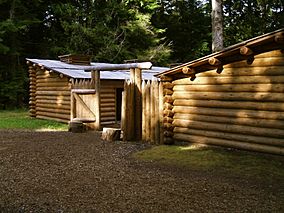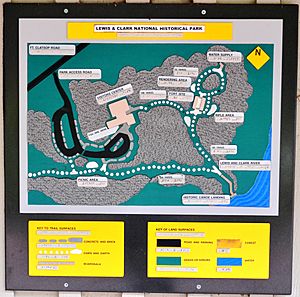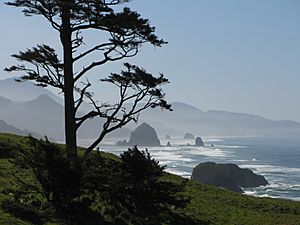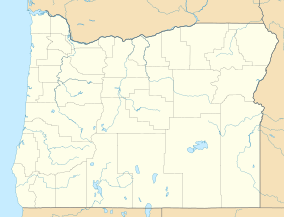Lewis and Clark National Historical Park facts for kids
Quick facts for kids Lewis and Clark National and State Historical Parks |
|
|---|---|

Fort Clatsop replica built in 2007
|
|
| Location | Clatsop County, Oregon and Pacific County, Washington, USA |
| Nearest city | Astoria, Oregon |
| Area | 3,303 acres (13.37 km2) |
| Established | May 29, 1958 |
| Visitors | 293,356 (in 2017) |
| Governing body | National Park Service |
| Website | Lewis and Clark National Historical Park |
|
Fort Clatsop and the Salt Works
|
|
| Area | 125 acres (51 ha) |
| Built | 1805 |
| Architect | Capt. William Clark |
| NRHP reference No. | 66000640 |
| Added to NRHP | October 15, 1966 |
The Lewis and Clark National Historical Park is a special place near where the Columbia River meets the ocean. It celebrates the famous Lewis and Clark Expedition. This park is managed by the National Park Service and the states of Oregon and Washington working together. It became a National Historical Park on November 12, 2004.
After their long journey, the Corps of Discovery (Lewis and Clark's team) spent the winter of 1805–1806 at Fort Clatsop. Today, the park has a copy of the fort and a visitor center. It also includes other important historical spots in both Oregon and Washington.
Contents
Exploring Lewis and Clark's Historical Park

This federal park started as the Fort Clatsop National Memorial on May 29, 1958. It was added to the National Register of Historic Places on October 15, 1966. On October 30, 2004, it was renamed the Lewis and Clark National Historical Park. This new park included many more important places, such as:
- Fort Clatsop
- Fort to Sea Trail (opened November 14, 2005)
- Netul Landing
- Salt Works
- Station Camp/Middle Village
- Clark's Dismal Nitch
Oregon State Parks Connected to Lewis and Clark

Discovering Ecola State Park's History
Ecola State Park is where the Corps of Discovery hiked in 1806. They went on a tough journey to see a beached whale. Today, you can explore many miles of trails through old forests. There are also several beaches. You can see Haystack Rock and the Needles from many spots in the park.
Visiting Fort Stevens State Park
Fort Stevens is a large park with 3,700-acre (1,500 ha) of land. It offers chances to learn about history, nature, and have fun. This fort was part of a group of three forts that protected the mouth of the Columbia River. The other two forts were Fort Canby and Fort Columbia.
Relaxing at Sunset Beach State Recreation Site
Sunset Beach is the end point of the Fort To Sea Trail. This trail starts at Fort Clatsop. Sunset Beach also gives visitors direct access to the Pacific Ocean. You can enjoy wide views from Cape Disappointment to the north and Tillamook Head to the south.
Washington State Parks Connected to Lewis and Clark
Exploring Cape Disappointment State Park
Cape Disappointment State Park is a large camping park on Cape Disappointment. It used to be called Fort Canby State Park. This park has 1,882-acre (762 ha) of land right on the Pacific Ocean. You can find 27 miles (43 km) of ocean beach, two lighthouses, and a visitor center. There are also hiking trails and the remains of Fort Canby. The Cape Disappointment Historic District was added to the National Register on August 15, 1975.
Learning at Fort Columbia State Park
Fort Columbia State Park protects Fort Columbia. This was a coastal artillery post along the north side of the Columbia River's outlet. The park is 593 acres (240 ha) and has a visitor center. This center teaches about the fort and the history of the area.
Chinook Point is also part of this park. This is where an American captain, Robert Gray, first saw the Columbia River. His explorations helped the United States claim this land later on. Chinook Point was named a National Historic Landmark in 1961.




